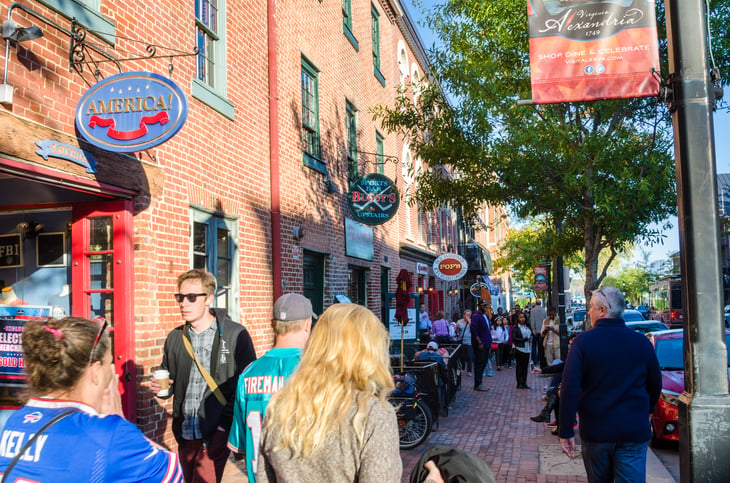
The U.S. economy is the largest in the world, with a gross domestic product of about $19.5 trillion. But how is that wealth distributed across the nation’s biggest cities?
An Axios analysis uses 2017 data from the Bureau of Economic Analysis to examine which metropolitan areas have the highest GDP in the United States.
Here’s what it found.
10. Atlanta-Sandy Springs-Roswell, Georgia

Gross domestic product (GDP): $385.5 billion
As one of the best large cities in the U.S. to start a small business, the Atlanta metro area offers access to an educated workforce and job growth.
The state capital’s metro area continues to see job growth that beats the national average; construction and the professional and business services industry are the two sectors seeing the largest year-over-year gains in the job market.
9. Houston-The Woodlands-Sugarland, Texas

Gross domestic product (GDP): $490.1 billion
Over the past year, home values in Houston increased by 4.5%, according to Zillow.
Although the metro’s housing market is cooling a bit, according to Zillow there is still some room for growth.
Additionally, wages have been on the rise here, with the Bureau of Labor Statistics reporting that total compensation costs for private industry increased by 1.4% for the year ending June 2019.
8. Philadelphia-Camden, New Jersey-Wilmington, Delaware

Gross domestic product (GDP): $445 billion
This tri-city metro area actually takes in parts of four different states (Pennsylvania, New Jersey, Delaware and Maryland) and accounts for almost half a trillion dollars in GDP.
Unemployment in this area was 3.7% in June 2019, according to the St. Louis Fed. That’s right in line with the current national average.
7. Boston-Cambridge, Massachusetts-Newton, New Hampshire

Gross domestic product (GDP): $438.7 billion
If you’re looking to invest in real estate, Boston was ranked this year as one of the top 10 cities for making that financial move because of the metro area’s strong jobs market in the STEM professions.
Through 2026, Boston-area jobs in science, technology, engineering and math are expected to grow 76% faster than the overall job market.
STEM jobs are expected to continue to be among the top-paying professions nationally, so a metro area where they show a significant presence can offer a lot of opportunities.
6. San Francisco-Oakland-Hayward, California

Gross domestic product (GDP): $500.7 billion
In San Francisco, the median list price per square foot for homes is $1,078 and the median home value is about $1.4 million, according to Zillow.
The average for the metro area, however, is less than half that at $503 per square foot. So, those looking for more affordable housing options while seeking to take advantage of the area’s wealth might choose cities surrounding San Fransisco, including Oakland.
The average wage in this metro area was $34.81 in May 2018, the latest data available from the Bureau of Labor Statistics. That’s about 39% above the national average.
5. Washington, D.C.-Arlington-Alexandria, Virginia

Gross domestic product (GDP): $530 billion
As of June 2019, this metro area’s unemployment rate was 3.4%, slightly below the national average. The sprawling region surrounding Washington, D.C., includes parts of three states — Virginia, Maryland and West Virginia.
The region’s leisure and hospitality sector enjoyed some of the biggest employment growth, year-over-year. Education and health services, with 2.1% growth in the same period, also saw robust growth.
Zillow rates the housing market as hot, although home values have declined 0.4% and are expected to drop more in the coming year, which could make the area a little more affordable.
4. Dallas-Fort Worth-Arlington, Texas

Gross domestic product (GDP): $535.5 billion
The second Texas metro area on this list has more than a half-trillion dollars of the nation’s wealth.
Total compensation costs for private industry workers in the region were up 2.2% year-over-year in June 2019, the Bureau of Labor Statistics says.
Additionally, the area saw nonfarm employment grow 2.9% between May 2018 and May 2019, compared with the national average increase of 1.5% for the period.
3. Chicago-Naperville-Elgin, Illinois

Gross domestic product (GDP): $679.7 billion
Local prices are up year-over-year as of June 2019 in this metro area, which includes parts of three states: Illinois, Indiana and Wisconsin.
The Bureau of Labor Statistics reported in June that prices in the metro area grew 1% from the previous June.
This area, too, is looking at a hot real estate market, Zillow says, though home prices declined 0.6% in the last year. (A hot market for buyers, perhaps?) The median home value in Chicago alone is $226,400.
2. Los Angeles-Long Beach-Anaheim, California

Gross domestic product (GDP): $1 trillion
Showing its economic muscle with a GDP of $1 trillion, this metro area is famous not just for wealth but also for its beaches and warm weather.
As of May 2018, the average hourly wage in this area was $27.83, according to the Bureau of Labor Statistics. This represents an hourly wage of about 11% above the national average wage.
As you might expect in the L.A. region, some of the largest occupational groups include personal care and service, arts, entertainment, sports and media.
1. New York City-Newark-Jersey City, New Jersey

Gross domestic product (GDP): $1.7 trillion
The Axios analysis finds that almost 10% of the nation’s GDP resides in this one metro area, which includes parts of three states: New York, New Jersey and Pennsylvania.
New York City is one of the most expensive places to live, with housing costs a whopping 369% higher than the national average. In fact, you need a salary of more than $100,000 a year to buy a home in the Big Apple.
Interestingly, though, the median monthly rent price in New York City, $2,800, is lower than the $2,950 for the overall metro area of New York City, Newark and Jersey City, according to Zillow.
Do you live in one of the nation’s wealthiest cities? Share your experience with us by posting a comment below or at Money Talks News’ Facebook page.





Add a Comment
Our Policy: We welcome relevant and respectful comments in order to foster healthy and informative discussions. All other comments may be removed. Comments with links are automatically held for moderation.